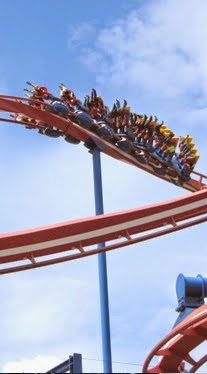 |
© Cedar Fair
|
Cedar Fair recently held their Q4 and year end 2021 conference call after their earnings report came out. You can check out the company's full press release
at this link. As in the past the conference call is used to go over their figures, but there are always some other tidbits in there too - some notes from which are below.
• On a high level view of financials, revenues in 2021 were $1.34 billion, compared to $1.47 billion in 2019 - the last pre-pandemic year. Attendance was 19.5 million guests, down 8.4 million from 2019. Out of park revenues of $168 million was comparable to 2019. Per capita spending hit a new record of $62.03, 28% higher than 2019. Full year EBITDA was $325 million in 2021, compared to $505 million in 2019. Net income, however, in 2021 was a loss of $49 million compared to a gain of $172 million in 2019.
• Digging into attendance a bit more, in 2019 the parks had a total of 2,224 operating days, in 2021 they did 1,765. Overall totals in 2021 were about 70% of 2019 attendance, but on a day to day comparison closer to 85%. In the 4th quarter of 2021 there were actually 21 more operating days in total than in 2019, as Cedar Fair extended park schedules "where appropriate." They expect to increase operating days 35% in 2022, to almost 2,400 days (more than in 2019) and operating hours will be nearly 60% higher than in 2021.
 |
© Cedar Fair
|
• With regard to the record per capita spending, they note that all revenue channels saw increases - especially admissions, food and beverage and extra charge attractions. Cedar Fair points out that while consumer spending was strong this year, they also credit the food and beverage lift to "building a more robust culinary infrastructure capable of delivering higher quality" offerings over the last 5 years.
• Looking just at Q4 of 2021 when compared to 2019, the results were good. Revenues were up 36% or $94 million over 2019, attendance increased 5% or 246,000 visits and out of park revenues were up $6 million to $34 million. Per capita spending for the quarter was up 34% as well. EBITDA for the quarter was $73 million, a record, up $19 million over 2019.
• At the end of the year the company's cash was at $61 million with $359 available on credit. The revolver credit had no balance at year end, and no large maturities are due until 2024.
 |
© Cedar Fair
|
• The labor market situation is still evolving and they expect to see higher labor costs again this year, mostly due to having more days and operating hours. They do see the return of visas for international workers, which can help with staffing. Having return employees from 2021 will also help, as 2020 was so fragmented there were much less returning workers in 2021.
• Going cashless has helped guests to utilize apps to pay and also reduced lines in the parks. It has also increased the number of sales per hour which is meaningful for the company. They are also leaning on technology to continue to market to guests better and to help with labor costs.
• Cedar Fair again confirmed that SeaWorld Parks & Entertainment made and offer to purchase the company, starting at $60 a unit. They said they then "informally" upped the offer to $63 a share, however after due diligence that still wasn't an offer that was deemed "in the best interest of the company and its unitholders."
 |
© Cedar Fair
|
• Due to the performance in the 2nd half of 2021, Cedar Fair anticipates returning the quarterly distribution to unitholders as soon as Q3 2022, possibly sooner. No work yet on at what level it will return, but they want to make sure it is sustainable and able to grow over time.
• Capital spending plans for 2022 include between $170 to $175 million on "new rides, attractions and other park improvements to support future growth at our parks." That's a sizable number, which is good news for park fans. Considering timing, a lot of that is probably to start projects for 2023. They will also spend another $40 million to complete renovations at Sawmill Creek Resort and Castaway Bay.
• The company will also continue to pay down long term debt until they are below $2 billion. In December they redeemed bonds due in 2024 using $450 million cash on had, removing close to half of the debt taken on during the pandemic in 2020.
• 2022 season pass sales are strong, with a 8% increase in average season pass price and "higher penetration rates" for all-season add-ons. Deferred revenues at year end, which is mostly from season passes, was at $198 million, up $37 million from 2019.














































